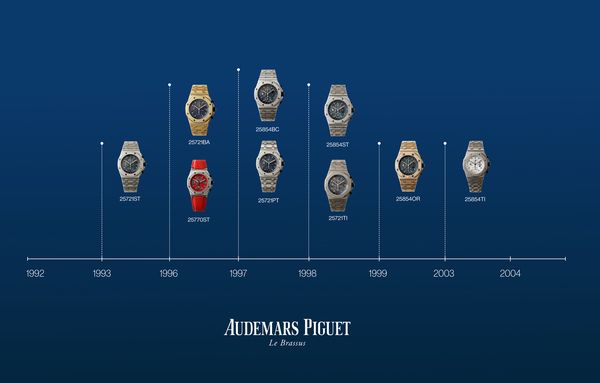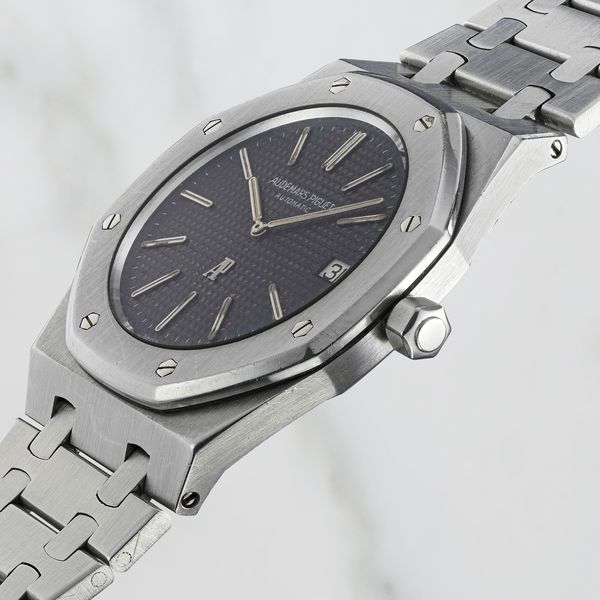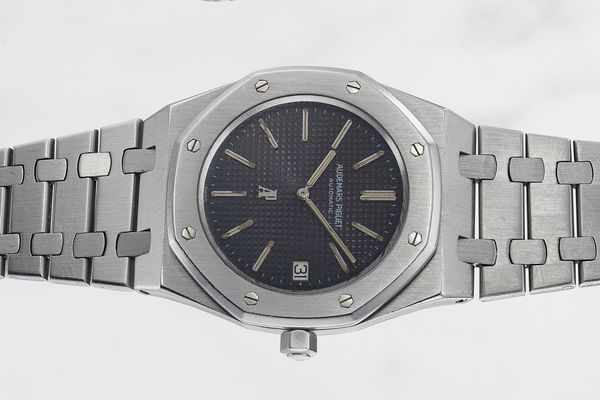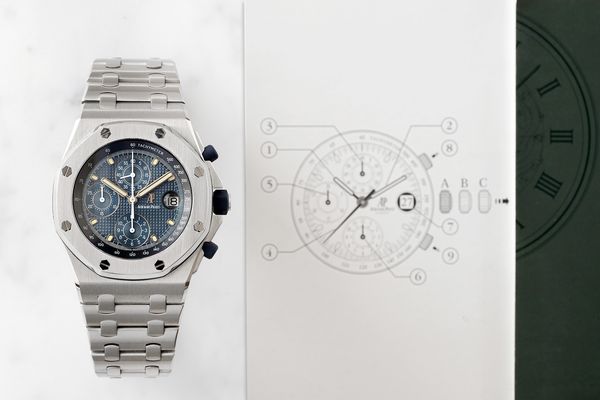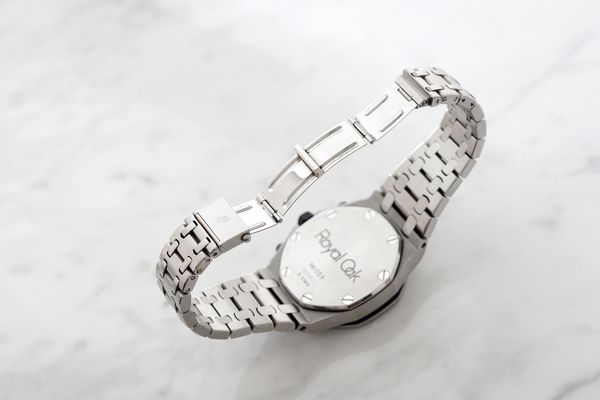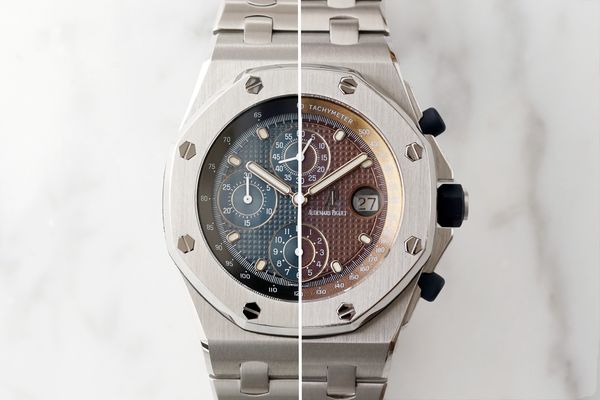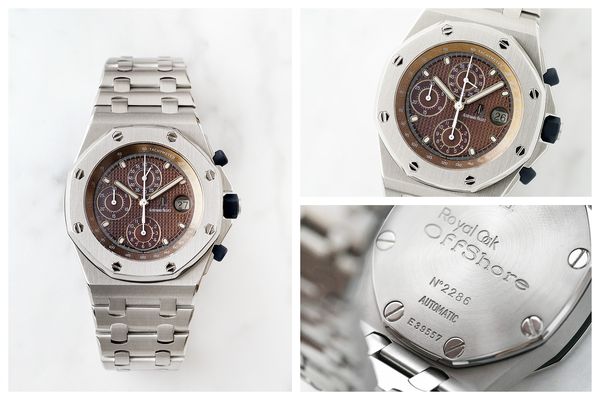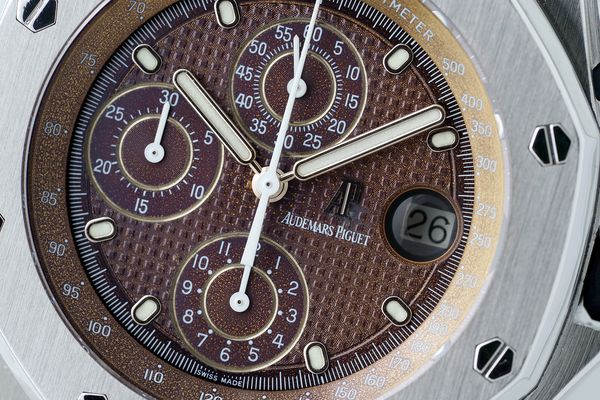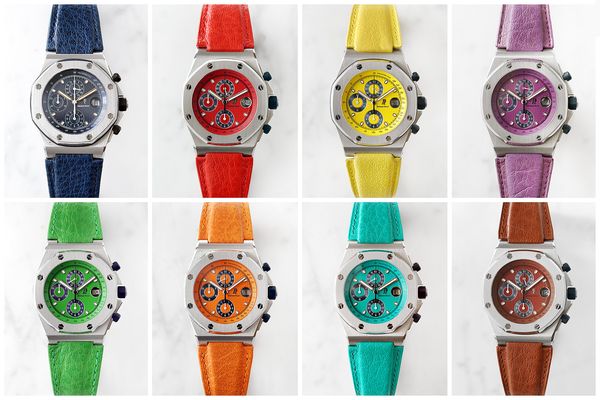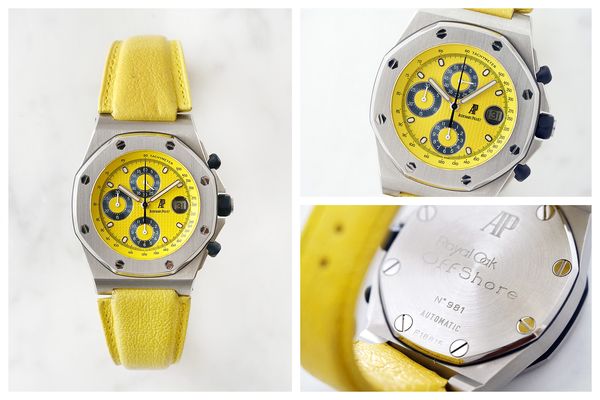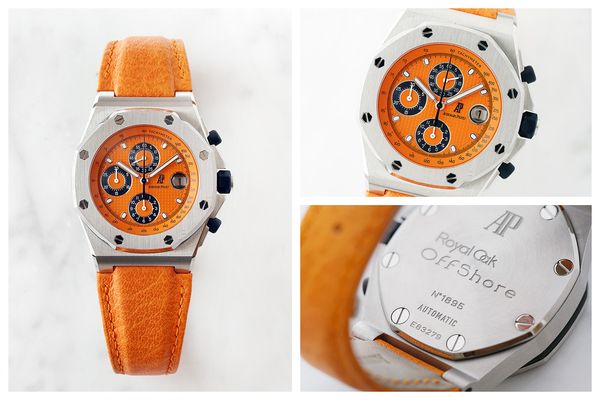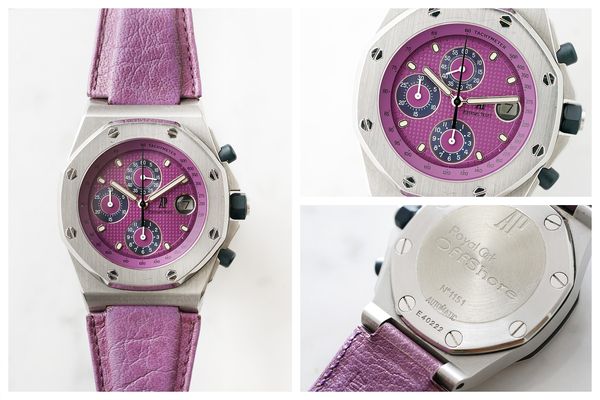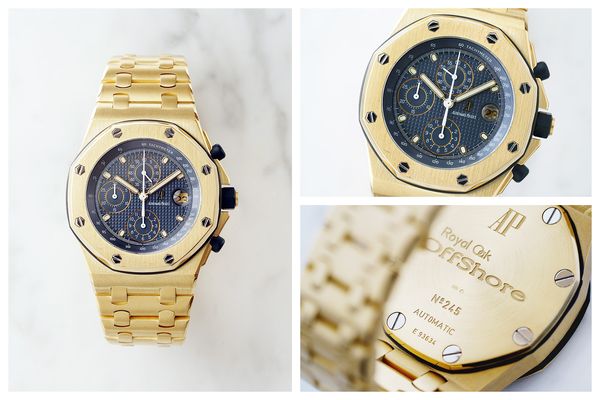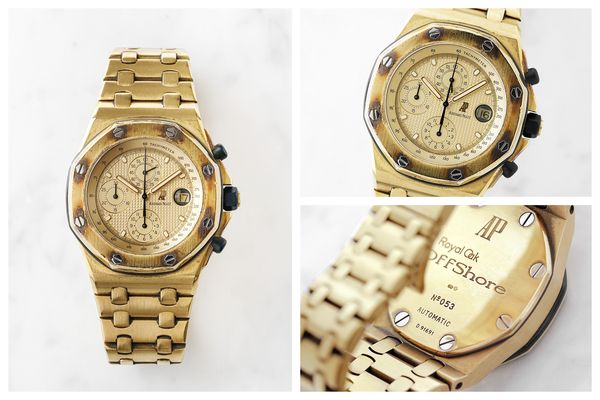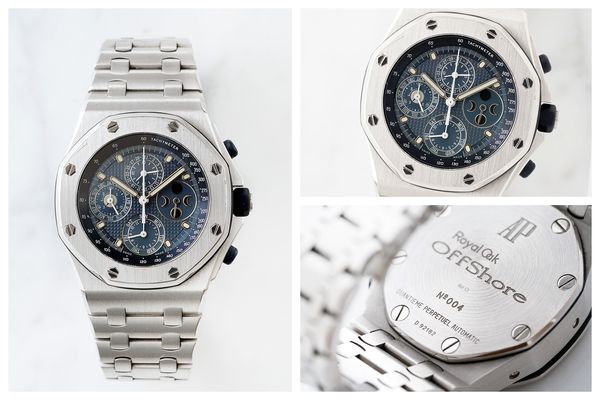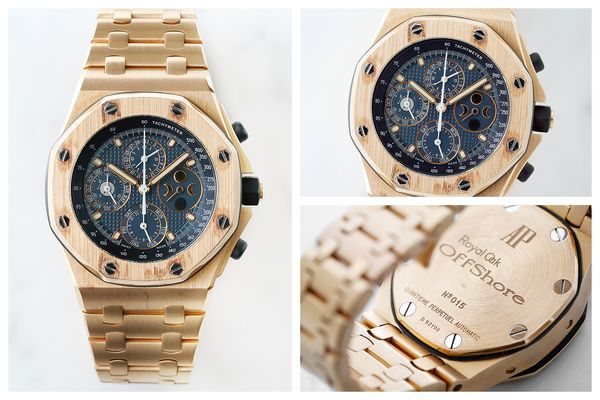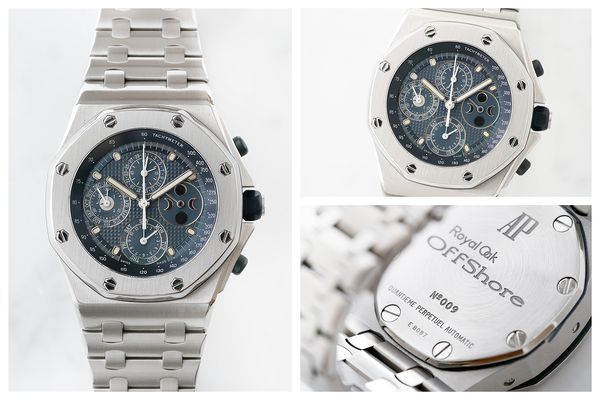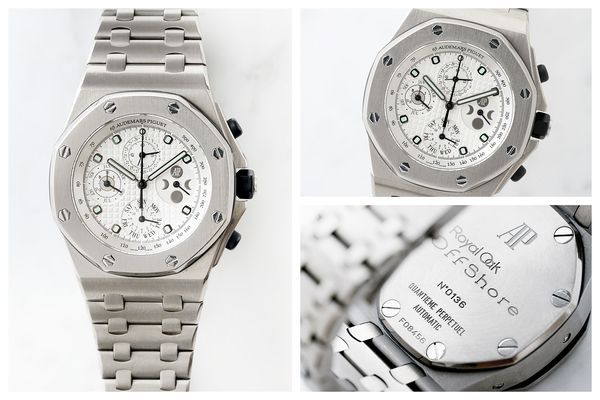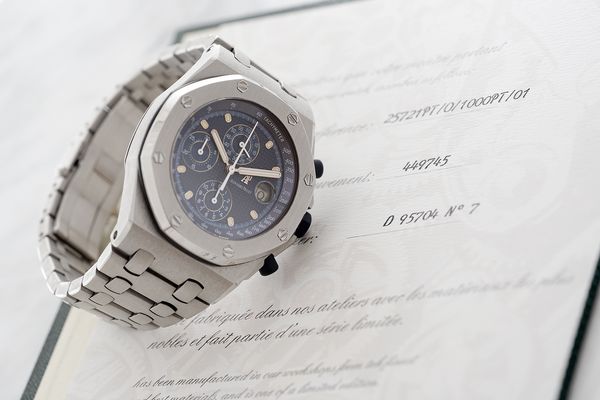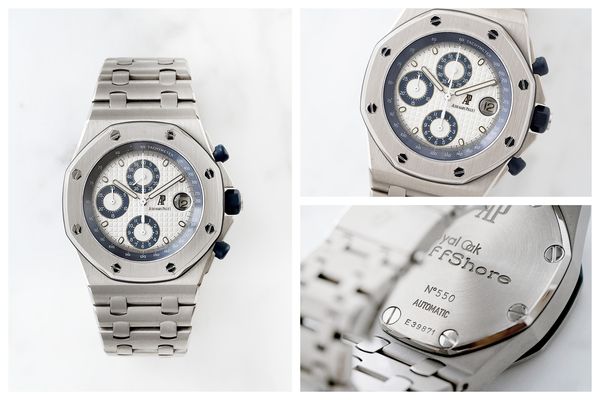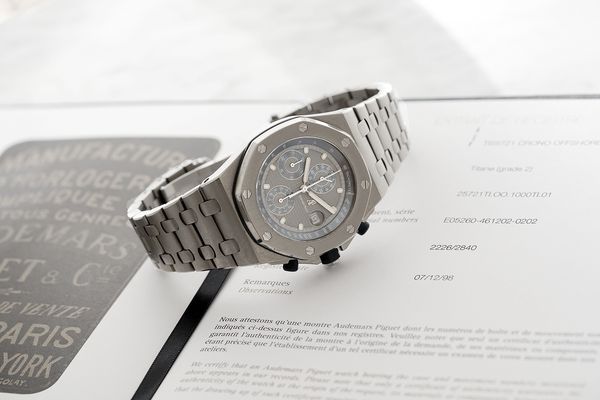The PHILLIPS Hong Kong Watch Auction: XVIII, takes place on May 24 and 25, 2024, at our West Kowloon headquarters. The auction includes more than 280 of the world's finest watches – and though we are loath to boast, we truly think it's one of the best catalogs we've ever put together. We'll be highlighting a number of the most interesting watches and stories featured in the sale, including lot 954, a fantastic example of an Audemars Piguet Royal Oak Offshore 'The Beast' ref. 25721TI from 2000 (not the same example featured in this story).
- By Arthur Touchot
Editor's Note: The following article was published in March 2020, and at the time of its publication, none of the watches were for sale. However, we are offering this November, two of the watches mentioned below, the Royal Oak Offshore “Beast” Ref. 25721PT in Platinum and the Ref. 25854OR in pink gold. To learn more about these pieces, please visit our Geneva Watch Auction: XII catalogue and review the footnotes dedicated to each watch.
Launching “The Beast”
More than 25 years after its launch, the Offshore is a watch that has carved its own, unique, and somewhat unexpected position in the Audemars Piguet catalogue. Today, the Swiss watchmaker offers more than forty different Offshore models ranging from a faithful re-edition of the original chronograph, made in 1993, to much more complicated versions featuring high-end complications and avant-garde materials. There are also several ISO certified models made for recreational diving that feature a single screw-down crown, and though quite a bit different from the original Offshore, bear its name – such is the weight of it.
Audemars Piguet has relied on it to provide excitement, and more importantly, to generate sales, which has led to its dominant position within the company’s catalogue – a position that is partially responsible for introduction, last year, of the Code 11:59, a brand new family of watches designed to reduce the brand’s dependency on anything with the word “Oak” in its name.
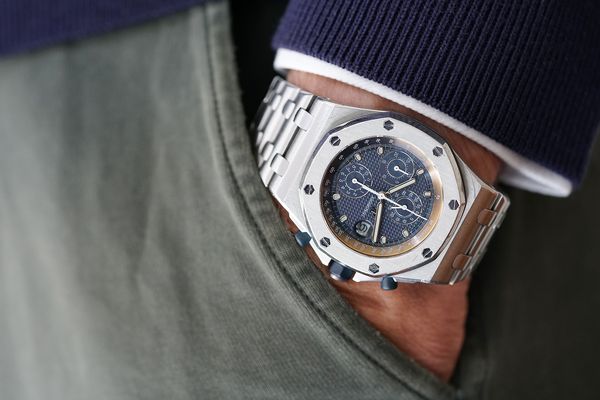
But the popularity the Offshore enjoys today only arrives after some experimentation with its original design. Following its introduction in 1993 as “just” an anniversary piece to the original Royal Oak, the Offshore soon became the company’s favourite testing ground for new materials, limited editions, and high-profile endorsements.
Several Offshore models deserve a moment of appreciation for the model’s ultimate success, but in order to understand how “The Beast” became so influential, we will discuss some of the earliest examples – made between 1993 and 2004 - and highlight some of the lesser known incremental changes introduced during the first decade of the Offshore’s life. Some of these watches you may not have seen before.
They were generously lent to us by Alfredo Paramico, who, besides being one of the only collectors who can say his initials are present on every Offshore, was the first collector to recognize the watch’s importance. He has successfully hunted down some of the rarest examples found in amazing condition, and now shares them for the first time with the public.
Here's what he had to say about the challenge of putting together this collection.
The Collector - Alfredo Paramico
I have always been attracted by this watch and its massive design and it inspires the feeling of adventure whenever I look at it. After spending a few months trying to classify the rarest references I noticed the total lack of literature around this Audemars Piguet wristwatch. While we know all, or almost all of the well-known Royal Oak models, I found that the Offshore lived in uncharted territory. When I realised how rare some references were I decided to start this collection. I have always collected very rare timepieces and I can safely say this was one of the most challenging to put together. Some of the watches illustrated here, such as the purple, turquoise and green models Ref. 25770, I have barely seen in my life. The same is true of the perpetual calendars ref. 25854, especially in pink gold and in white gold. They are magnificent watches, with production numbers that very likely won't exceed the fingers of one hand. Without any doubt my favorite watch is the platinum D series ref. 25721. Not only is it the only example to have appeared so far in the market but it is, in my opinion, a true Audemars Piguet milestone and icon, very likely one of the rarest Audemars Piguet ever produced.
But first, a (very brief) recap
It is indeed impossible to talk about the Royal Oak Offshore without first talking about the Royal Oak, a watch so visibly present in the design of the Offshore that Audemars Piguet could not drop its name from the new line. That, and the fact the Offshore is an anniversary piece, of course.
Launched in 1972, the Royal Oak is a watch that changed Audemars Piguet. It presented a new definition of luxury, positioned the brand as the leader of an emerging product segment, and perhaps more significantly, changed the culture inside the manufacture – the company had barely worked with stainless steel up until that point.

Audemars Piguet President Georges Golay (left) and Gerald Genta, the designer of the Royal Oak (right). Credit: The Hour Glass.
For Georges Golay, the company’s President between 1966 and 1987, it was a bold move but one that was required to re-invigorate the brand and generate sales, following years of steady decline.
The Royal Oak was the first luxury stainless steel sports watch with integrated bracelet, an interesting paradox. On the one hand it was made in steel – and quite a lot of steel parts for that matter – and on the other, it was so finely made that it cost more than a high-end gold watch. Inside the Royal Oak was the world’s slimmest automatic movement with a date window, the calibre 2121, and outside was a case that received the level of finishing previously reserved for precious metals.
The Royal Oak was not universally accepted at first, but soon found itself adopting other complications and case materials. The model’s ability to transform into something other kept it relevant over the years, and would lead to its most drastic evolution on the eve of its 20th anniversary.
One of the most controversial but ultimately influential watch revamps of the 20th century, the Royal Oak Offshore felt familiar in many ways – the octagonal bezel with apparent screws, the grid-like “tapestry” dial and the integrated bracelet design all remained – but in a much larger, 42mm package.
While remaining faithful to the core tenants of Genta’s design – the octagonal bezel and Tapisserie dial - Emmanuel Gueit injected some testosterone into the line which, crucially, welcomed a chronograph for the first time ever, and introduced Therban® rubber details.

Emmanuel Gueit, the man in charge of delivering the Offshore
Audemars Piguet therefore worked long and hard behind the scenes on the development of the new piece, and ironically, the company faced complications that delayed the watch’s introduction until 1993, one year after the Royal Oak’s milestone anniversary.
“The construction took time because it was never as simple as just making it bigger,” says Audemars Piguet's Museum Archivist, Raphäel Balestra.
The reasons for this “weight gain” were not just cosmetic, but a direct consequence of its re-engineering, and the addition of: A Dubois-Depraz chronograph module to the watch’s existing JLC calibre 888, a soft-iron cage shielding it from magnetic fields, and an outer flange on the dial for the tachymeter scale –making the Offshore one of the more literal examples of the “form follows function” design principle of contemporary watchmaking.
Just like the Royal Oak in 1972, the Offshore was heavily criticized at first: too big, too different. The watch received criticism from all sides, and perhaps most of all from those who had worked on the original Royal Oak. Instead of flattering its original creator, the Offshore’s exaggerated proportions angered Gerald Genta and the Swiss designer publically criticized the company’s decision to use the Royal Oak’s name to promote a watch that, he felt, stripped away its essence.
To some degree, the general public, who did not share Genta’s obvious bias, felt the same way, and just like the Royal Oak in 1972, the Offshore made a pretty poor first impression at the fair.
“A lot of people judged this watch a mistake for Audemars Piguet," admits Balestra. “They did not like it."
While the Offshore was not accepted by the company’s typical clientele, it also brought new faces to the Audemars Piguet booth, and just like the Royal Oak, it eventually found fans…in Italy, where it became a favourite among young and wealthy Italians. It received further recognition when one of the country’s most beloved athlete, Alberto Tomba, started wearing the watch.
A national hero, winner of three Olympic gold medals in alpine skiing, Tomba “La Bomba” was the first of many larger than live characters to champion the Offshore on their wrist and become an ambassador of the brand, and Audemars Piguet soon made the watch the focus of high-profile marketing campaigns and limited editions that gave the company visibility like it had rarely enjoyed.
Collaborations with Formula One drivers Michael Schumacher and Rubens Barrichello, and Hollywood actor Arnold Schwarzenegger made Audemars Piguet known internationally, and brand recognition was strongest through the Offshore – something no one in Switzerland would have believed just a few decades earlier.
Presenting “The Beast” - Ref. 25721ST
As is the case with many new model introductions, the Offshore’s design was subject to a couple of evolutions right from the start, and several clues – besides the numbered case - allow us to determine its age relative to the first model made in 1993. These clues can be found on the case, bracelet, and dial, as follows:
Case:
The word Offshore does not appear on any of the first 100 models produced. Instead, you will only find the words “Royal” and “Oak”, as shown in the following examples, numbered 51 and 59.
Phillips has sold only two of the fabled “first 100” models, N° 39, formerly owned by the Offshore’s designer and sold for CHF 102,500 during the Geneva Watch Auction: EIGHT.
N° 39, formerly owned by Emmanuel Gueit, the Offshore's designer.
Please note, numbers are linked to the reference and the material of the models. So the stainless steel models numbered 51 and 59 are the 51th anf 59th Ref. 25721ST made in stainlesss steel, while the yellow gold N° 53 is the 53rd yellow gold Ref. 25721BA.
Bracelet Construction
The first 500 Offshores were fitted with a stainless steel bracelet that features a double-folding clasp with a central piece that is thin and “entire” – as seen in the example N°59 above – while later examples come with a bracelet that is built similarly expect the central piece presents two openings.
D – E – F Serials
Other, more subtle changes in the dials show the true age of the stainless steel “Beasts”
Small imperfections in the production process meant the same model Ref. 25721ST was fitted with three dial variations throughout its production cycle, with D and E-series dials fitted between 1993 and 1999, and F-series dials between 1999 and 2004. Let’s quickly compare two watches fitted with D and E-series dials
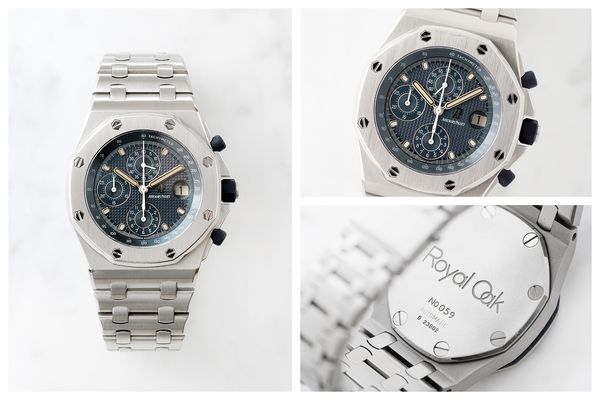
The watch above, numbered 59, is part of the first 1,000 pieces, all fitted with D dials with the following characteristics:
- A comparatively “tighter” tapisserie motif with more squares fitted inside the dial diameter.
- An “unstable” coat of blue paint that occasionally and over time let the brass plate on the dial appear beneath the paint.
The watch on the right is a watch made a little later, but before Audemars Piguet’s decision, in 1999, to change dial suppliers. The characteristics of the E-series dials are the following:
- The hue of blue used is noticeably different, closer to purple than to the original shade of blue introduced in 1993. Again, these tend to discolor over time.
An extreme example of a D-series gone "tropical"
Finally, “The Beast” is fitted with the F-series dials between 1999 and 2003. These are recognizable for the following reasons:
- A much more stable paint is used. These watches are typically found with dials that dot not look aged at all, unless damage is present.
The watch magazine Watch Collecting Lifestyle has published a very comprehensive guide on “The Beast” and all of the changes it goes through, especially during the first years of production. Anyone interested in diving deeper into these changes should use it as a reference, but the main takeaway is that this is a watch whose design is much more fluid than its bold lines would suggest.
D vs E Boxes
Finally, the boxes of Offshore models appears to change with the switch from D to E serials, as a smaller, window-less box is delivered with latter models.
The Tropical “Beast” – Ref. 25770ST.OO.0009.XX (XX = 01 to 08)
Just like the Royal Oak and the Royal Oak Offshore, the first truly novel iteration of the Offshore was introduced at Baselworld 1996, three years after the introduction of “The Beast” and Audemars Piguet again showed little restraint with the launch of eight extremely adventurous and colourful models.
While still the same below the surface, the new Ref. 25770ST looked like an entirely new watch. But no, the only major difference between the original reference and the new ones was the introduction of leather straps – a first for the Offshore – that matched new, vibrant dial colours that totally changed the watch’s aesthetic.
In comparison to these watches, “The Beast” suddenly looked quite tame, but this colourful set of watches – officially (01) Deep Blue, (02) Yellow, (03) Orange, (04) Red, (05) Maroon, (06) Purple, (07) Turquoise, and (08) Green - were an early signal of the numerous other changes the watch would later go through, and were the start of its slow transformation from being an oversized, stainless steel tool watch, to becoming a fashionable, forward-thinking, status symbol.
On the wrist, the flashy Ref. 25770ST models produce a completely different wearing experience. They’re obviously much lighter on the leather straps, and unlike “The Beast”, which feels like a watch that’s trying to intimidate others, they present a fun side to high-end watchmaking that wasn’t necessarily apparent until then.

More than any other Offshore from that era, this first re-design will also be the one that has the most lasting impact on the line. Most of today’s Offshores are offered on non-metallic bracelets – synthetic rubber is now the go-to, with leather also a popular option – and the Offshore is by far the most colourful collection – think of it as the Nike shoe of the horological world.
While Audemars Piguet could not share production numbers for these watches, the company confirmed that it was extremely rare for a single collection – such as this one – to feature all of the colour variants, and that the (06) Purple version is the one they saw come up “the least”, suggesting it could be the rarest in the set.
1996: Offshore Goes Gold, with “The Beauty” Ref. 25721BA
Quite soon after the release of the stainless steel 25721ST, Audemars Piguet releases the first statement piece of the Offshore collection with its first model made completely out of gold.
Making and finishing the 42mm case and, more importantly, all the links of the Offshore’s bracelet from 18k yellow gold truly places the brand in a class of its own. It also repositions the Offshore and clearly shows the brand’s ambition with the watch beyond its original, utilitarian appeal.
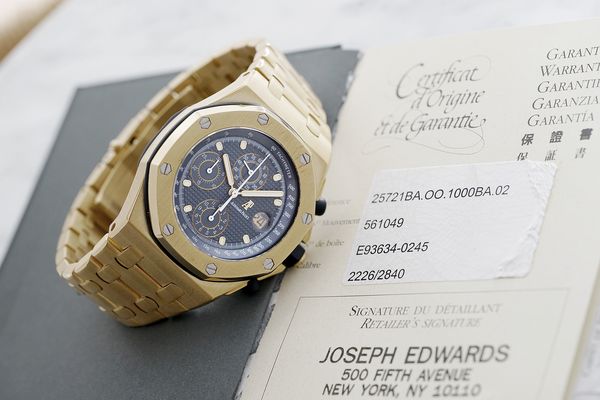
Second only to Rolex in that regard, Audemars Piguet seems happy to ignore the industry’s typical use of materials to classify their collection – stainless steel for sports watches, yellow or pink gold for dress watches – and shows its intention of rolling out its iconic sports watch in more than one metal.
Gold Offshore models - the 25721BA is also known as "The Pounder" due to its weight of 418 grams - are extremely rare compared to their stainless steel cousins. They are fitted with either blue D-series dials, like the ones available in the Ref. 25721ST, and later with E-series champagne dials. Two-tone versions, in pink gold and stainless steel and their reverse, are rarer still. The present example, N° 64, is one of only 4 known.
Audemars Piguet is now totally uninhibited, and the Offshore goes from the lightest its ever been on the leather straps to the heaviest. For now.
Offshore Perpetual models
Having previously tinkered with the design of the Ref. 25721ST and added the yellow gold and the “tropical” models to its collection, Audemars Piguet presented a decidedly more high-end version of the Offshore at the 1997 fair by going all-out with the introduction of the Ref. 25854BC – the first of four perpetual calendar versions of “The Beast” – stainless steel, rose gold, and titanium versions would follow the first, appropriately noble, white gold model.
The Ref. 25854BC, the first white gold QP Offshore.
With this reference, Audemars Piguet launches the first Offshore with a more elaborate calibre, and only the second Offshore in a precious metal, in what will become a defining year for the model and its evolving status within the company’s collection.
These are the latest in a series of bold moves for the company, who places one of its favourite, most delicate and most exclusive complications inside an unlikely candidate – a built-for-survival 42mm watch previously marketed as a nautically themed tool watch – and swiftly reminds everyone that it remains the father of the perpetual calendar.
The same reference in red gold.
The strategy wasn’t totally novel to the brand. Audemars Piguet had done exactly the same with the introduction of their first perpetual calendar in a Royal Oak in 1982, exactly 10 years after the launch of the original, time-only model. But the audacious paradox once again presented the watchmaker’s desire to redefine luxury and show its playful side.
“At Audemars Piguet, we are uncompromising with our quality but we don’t take ourselves too seriously at the same time” said Balestra. “This spirit can be felt through our products and perhaps even more in the Offshore.”
This is very different to the strategy Patek Philippe adopts with its own Gerald Genta deisgned sports watch. While the Royal Oak transforms into the Offshore and adopts multiple complications, the Nautilus remained largely unchanged – the first calibre upgrade is the arrival of a power reserve in 1998 – one year after the Offshore Perpetual Calendar is launched.
The Ref. 25854ST, the steel version of the QP Offshore.
The original Offshore QP collection is completed with the launch of a stainless steel version in 1998 (Ref. 25854ST) and a pink gold version in 1999 (Ref. 25854OR), though strangely, the stainless steel model isn’t mentioned in an Audemars Piguet catalogue until 2000, before the introduction of a final, titanium version in 2003 featuring a white F-series dial.
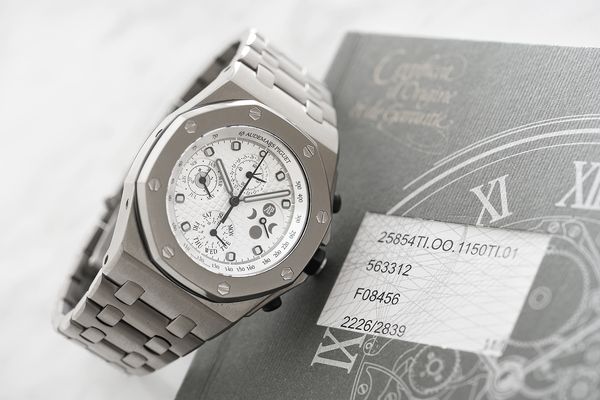
As far as we know, Audemars Piguet did not make this model in yellow gold.
Other rare models
While the first few years of the Offshore’s story are dominated by introductions in stainless steel, and then gold, those that follow feature even more exclusive and avant-garde materials as the company comes to fully embrace the popularity of its oversized sports watch as well as the changing profile of its clientele.
Here are some of the rare pieces that played a role during this transition period. While they may not be the best known or the most iconic, they highlight the incremental changes the Offshore witnesses over the years.
1997: The Royal Oak Offshore “Beast” Ref. 25721PT in Platinum
When asked which Offshore was the rarest, Baseltra responded without any hesitation: the platinum Ref. 25721PT ! Although he could not confirm the exact number of models cased in platinum, it is safe they were part of a very small production.
You can imagine the incredible weight of the watch! I have personally never worn a watch like it and it has left a massive impressive on me – pardon the pun.
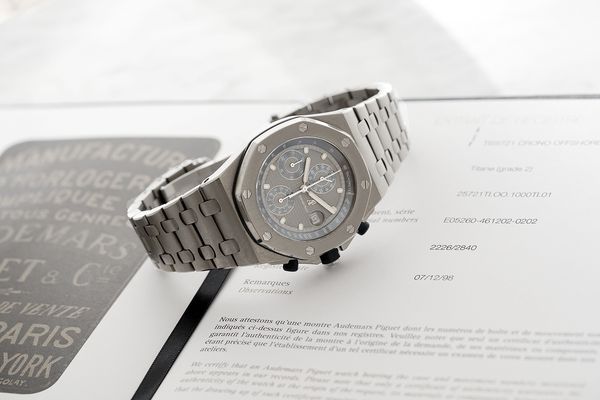
1998: The Royal Oak Offshore “Beast” Ref. 25721TI in Titanium
Following the heaviest Offshore, Audemars Piguet would present the lightest. Made entirely out of titanium, the Ref. 25721TI comes with several dial configurations including a grey dial, but also a white and blue panda-like dial – the first of many like it.
In fact, it is this type of polychromatic dial that will Audemars Piguet will turn to for most of the Offshore’s future executions, and even more so following the incredibly popular 6-piece line-up of 42mm models featuring navy and white, black and red, and “Safari” dials.
1999: The Royal Oak Offshore “End of Days” Ref. 25770
Arguably one of the most influential limited editions in the Offshore family, the watch was a collaboration between Audemars Piguet and Arnold Schwarzenegger for his movie End of Days in 1999.
Following the film’s release, the “End of Days” limited edition became one of the most well-liked models of the collection. The watch was also the first Royal Oak Offshore to be darkened by a PVD treatment, and was limited to 500 models.
Conclusion
One of the most controversial but ultimately influential watch releases of the past 30 years, the Offshore is a watch that almost every enthusiast has seen – in one form or another – often on the wrist of an athlete or celebrity, or on social media. It feels like it is everywhere and at the same time it is difficult to pin down exactly what it looks like because so many different models exist.
The truth is that the Offshore is a watch that was destined to evolve, and changes to its design happened almost instantly and throughout the first few years of its production. Those early watches – made during the original run of the Ref. 25721ST – proved how versatile and marketable “The Beast” could be, and with time and imagination, those incremental changes turned what was once an unpopular watch into an iconic design.
Now, those responsible for that transformation have become collectible models and one should not be surprised if the prices of these very rare and lesser known 90s examples continue to increase as their historical importance and influence on the whole Offshore becomes more evident.

Phillips Watches would like to sincerely thank Audemars Piguet and its Museum for their invaluable assistance during our research for this article.
